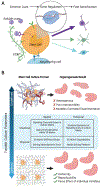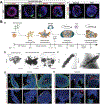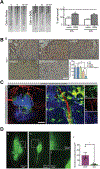Advanced Materials to Enhance Central Nervous System Tissue Modeling and Cell Therapy
- PMID: 33510596
- PMCID: PMC7840150
- DOI: 10.1002/adfm.202002931
Advanced Materials to Enhance Central Nervous System Tissue Modeling and Cell Therapy
Abstract
The progressively deeper understanding of mechanisms underlying stem cell fate decisions has enabled parallel advances in basic biology-such as the generation of organoid models that can further one's basic understanding of human development and disease-and in clinical translation-including stem cell based therapies to treat human disease. Both of these applications rely on tight control of the stem cell microenvironment to properly modulate cell fate, and materials that can be engineered to interface with cells in a controlled and tunable manner have therefore emerged as valuable tools for guiding stem cell growth and differentiation. With a focus on the central nervous system (CNS), a broad range of material solutions that have been engineered to overcome various hurdles in constructing advanced organoid models and developing effective stem cell therapeutics is reviewed. Finally, regulatory aspects of combined material-cell approaches for CNS therapies are considered.
Keywords: central nervous system; materials; organoids; stem cell; therapeutics.
Conflict of interest statement
Conflict of Interest D.V.S. and R.J.M. are inventors on patents related to stem cell manufacturing, and D.V.S., R.J.M., R.G.S., and H.J.J. are co-founders of a company that works on stem cell manufacturing.
Figures









Similar articles
-
Advances in Central Nervous System Organoids: A Focus on Organoid-Based Models for Motor Neuron Disease.Tissue Eng Part C Methods. 2021 Mar;27(3):213-224. doi: 10.1089/ten.TEC.2020.0337. Epub 2021 Mar 3. Tissue Eng Part C Methods. 2021. PMID: 33446055 Review.
-
Central nervous system organoids for modeling neurodegenerative diseases.IUBMB Life. 2022 Aug;74(8):812-825. doi: 10.1002/iub.2595. Epub 2022 Jan 31. IUBMB Life. 2022. PMID: 35102668 Review.
-
Bioengineering Approaches for the Advanced Organoid Research.Adv Mater. 2021 Nov;33(45):e2007949. doi: 10.1002/adma.202007949. Epub 2021 Sep 24. Adv Mater. 2021. PMID: 34561899 Free PMC article. Review.
-
Human pluripotent stem cell-derived lung organoids: Potential applications in development and disease modeling.Wiley Interdiscip Rev Dev Biol. 2021 Nov;10(6):e399. doi: 10.1002/wdev.399. Epub 2020 Nov 3. Wiley Interdiscip Rev Dev Biol. 2021. PMID: 33145915 Review.
-
Biomaterial-guided stem cell organoid engineering for modeling development and diseases.Acta Biomater. 2021 Sep 15;132:23-36. doi: 10.1016/j.actbio.2021.01.026. Epub 2021 Jan 22. Acta Biomater. 2021. PMID: 33486104 Free PMC article. Review.
Cited by
-
Investigation of neuro-regenerative therapeutic potential of nerve composite matrix hydrogels embedded with adipose-derived stem cells.Matrix Biol Plus. 2024 Nov 16;24:100165. doi: 10.1016/j.mbplus.2024.100165. eCollection 2024 Dec. Matrix Biol Plus. 2024. PMID: 39633894 Free PMC article.
-
Progress in spinal cord organoid research: advancing understanding of neural development, disease modelling, and regenerative medicine.Biomater Transl. 2024 Nov 15;5(4):355-371. doi: 10.12336/biomatertransl.2024.04.003. eCollection 2024. Biomater Transl. 2024. PMID: 39872925 Free PMC article. Review.
